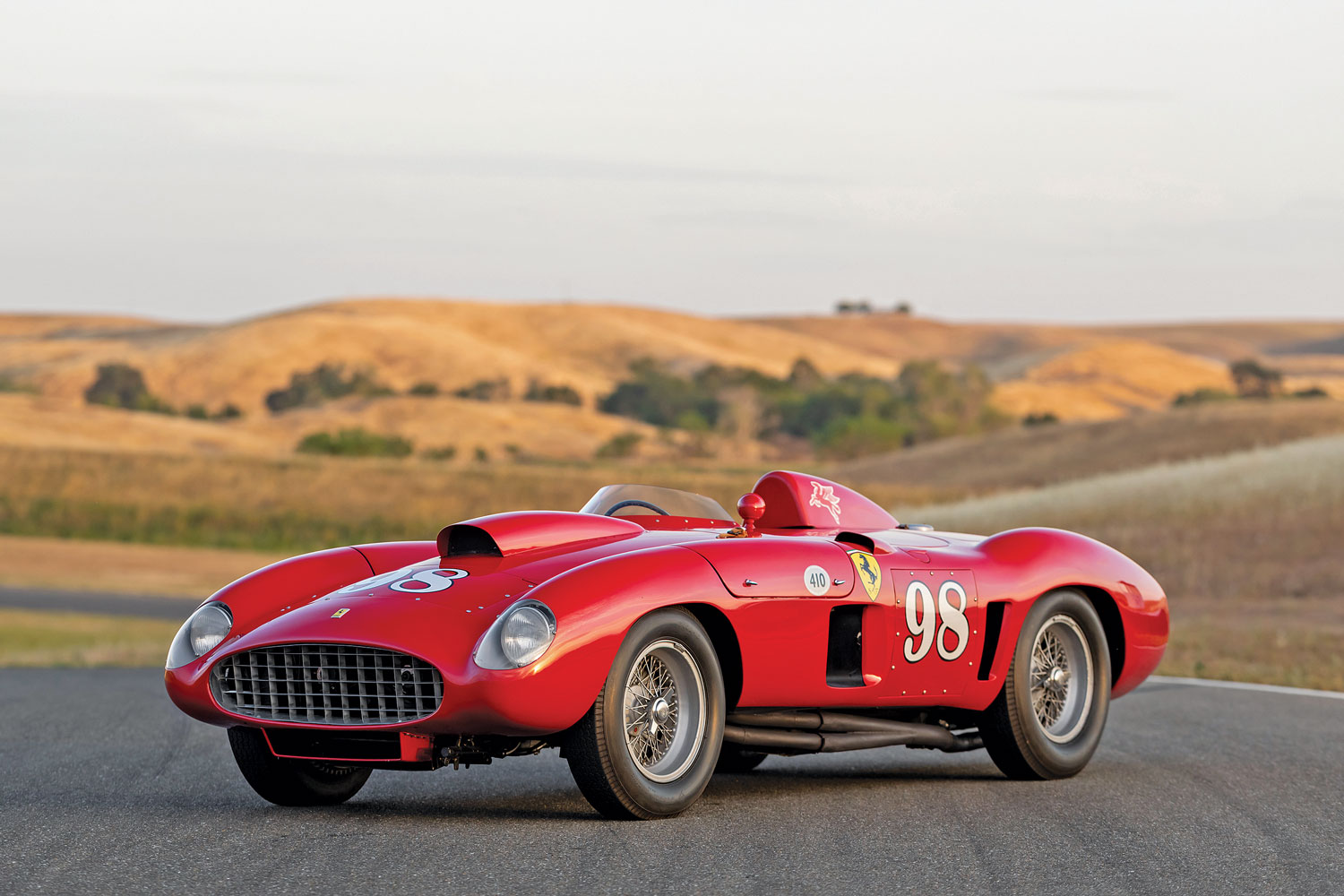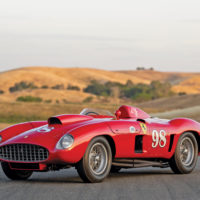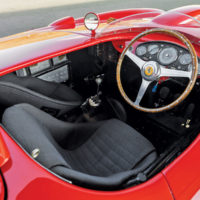Enzo Ferrari was determined to secure the FIA World Sportscar championship in 1955, with the final leg being the Carrera Panamericana. A grueling five-day rally, it traversed the Mexican wilderness en route to the border near El Paso, TX.
For the 1955 Carrera, Ferrari designed an all-new chassis, the type 519/C. It utilized a low-riding tubular spaceframe of unusual width and featured a shorter wheelbase, with the hopes of neutralizing the Panamericana’s uneven roads. Instead of integrating the 375 Plus’s 4,954-cubic-centimeter racing engine, however, Lampredi chose to revise his brand-new long-block V12 designed for the Superamerica road car. At 4,961 cubic centimeters, this was the largest engine yet built by Maranello, and in racing form the type 126/C motor featured Formula One-style twin-plug ignition per cylinder, a quadruple distributor and coil-ignition system in 0598 (magnetos in 0596), and three huge twin-choke Weber 46 DCF carburetors to develop nearly 400 horsepower.
Only two 410 Sports were built to these specifications with the intention of factory-based racing. They were appropriately designated chassis numbers 0596 and 0598 with CM suffices, standing for “Carrera Messicana.” After development had begun on the 410 Sport in 1955, however, both the Carrera Panamericana and 1,000-km Nürburgring FIA races were canceled in the wake of the Le Mans tragedy. As a result, Maranello repositioned the 410 Sports to participate in the 1956 World Sportscar Championship racing season, making their debut at the season-commencing 1,000 km of Buenos Aires in January 1956.
The pair of 24-spark cars, chassis numbers 0596CM and 0598CM, were respectively driven by the teams of Peter Collins and Luigi Musso, and Juan Manual Fangio and Eugenio Castellotti. Fangio furiously chased down Stirling Moss in the leading Maserati 300S. After charging back to the lead lap with Moss in his sights, the differential gave way from the punishment enacted by the feverish pace and raw power of the type 126/C engine on the 89th lap (28 laps after the transaxle had failed on 0596CM). Both cars were sent back to the factory for a refit before delivery later in 1956 to privateer clients.
SCM Analysis
Detailing
| Vehicle: | 1955 Ferrari 410 Sport Spider |
| Years Produced: | 1955 |
| Number Produced: | 4 (2 12-plug type 126 engine, 2 24-plug type 126C engine) |
| SCM Valuation: | $15,625,000 |
| Chassis Number Location: | Front left frame tube |
| Engine Number Location: | Right rear of block |
| Club Info: | Ferrari Owners Club |
| Website: | http://www.ferrariownersclub.org |
| Alternatives: | 1956 Ferrari 290 MM 1955–56 Maserati 300S 1957 Maserati 450S |
| Investment Grade: | A |
This car, Lot 355, sold for $22,005,000, including buyer’s premium, at RM Sotheby’s Monterey, CA, auction on August 20, 2022.
To complete the catalog copy above without spending too much space, this 410S under the ownership of John Edgar and with Carroll Shelby and others driving went on to a successful history in American racing from 1956 through 1959. It subsequently had an honored and well-maintained retirement with a series of important collectors.
The netherworld of crown-jewel car collecting — where extremely wealthy individuals vie for the right, privilege and responsibilities of owning and playing with the most valuable cars in the world — seems impossibly removed from most of our realities. But it is in fact a rational endeavor involving knowledgeable actors and clearly understood protocols. You might think of it as buying memberships in a series of informal clubs, joining a group of peers who know, respect and appreciate each other.
Evolving the breed
In trying to understand the amazing variety of sports racing cars that Ferrari produced during the classic years (roughly 1948–69), the best way to approach the issue is to consider four distinct generations.
The early racers of the first generation were fundamentally the same as the road cars: ladder-frame, live-axle cars with engines ranging from 2.0 to 4.5 liters of displacement and relatively crude suspensions, steering and brakes. The later large-displacement cars (340, 375) basically relied on horsepower to win, and in my experience are not particularly fun to drive. They can be quite fast, though.
Competition is a merciless master, and by 1954 it was becoming obvious that Ferrari was going to have to up its game. This is when what I call the second generation of racers was introduced. They were completely separate from the road cars, using tube-frame chassis with a transaxle layout that moved the weight distribution toward the center and allowed an independent De Dion rear suspension. Coil springs replaced a transverse leaf at the front, and steering and aerodynamics were improved. Bodywork was now bespoke to the racing cars, and lighter, simpler 4-cylinder engines were used for most of them. The best known of these cars are the Monzas and Mondials; virtually all of them were sold to retail customers as racing cars, Ferrari only kept a few for factory team use.
Inevitably, Ferrari moved back to using V12 engines for the factory cars, starting with the 250 Monza and progressing through our 410S to the 290 MM and 335 S of 1957. Lighter, slipperier and more sophisticated than the first generation, these are much better and a lot more fun to drive.
From good to great
The third generation arrived with both a return to simplicity and increased chassis and suspension sophistication. With an eye toward selling racing cars as a profit center, Ferrari put a V12 into the 2.0-liter 500 TRC chassis and called it a 250 Testa Rossa. It was a simple engine, transmission, live-axle layout, far less complex than the earlier transaxle cars, but it was profoundly better as a racer: The horsepower, grip, balance, steering and brakes all worked together.
The 1958 “pontoon fender” Testa Rossas became iconic. Ferrari built 21 of them before realizing that selling retail racing cars was a terrible idea and giving it up forever. After that, Ferrari only built sports racing cars for itself and sold them to privateers after retirement from Scuderia Ferrari. The 1959, ’60 and ’61 TRs are the ultimate, but they are all ex-team cars, hen’s-teeth rare (11 total), and frighteningly valuable.
The fourth generation of Ferrari racers are the mid-engine cars. They are fabulous but can never be driven on the street, which limits their usefulness and market value.
A hierarchy of value
This leaves the reference point as the late third-generation cars. I will argue that a useful approach is to think of any racing Ferrari’s value as a percentage of one of those. No TR 59 or 60 has traded hands publicly in recent memory, nor is one likely to, but consensus is that one would be worth about $45 million (GTOs are a different topic).
A second essential consideration in valuing these cars is the number of cylinders in the engine. With the exception of a few problematic sixes, all racing Ferraris of the Enzo era are 4- or 12-cylinder cars, and any racer’s value is in direct proportion to the cylinders: A 4-cylinder car is worth roughly one third of a 12-cylinder car.
History is the third determinate — the more wins the better — and because the market is international, world (FIA) history is more important than strictly American races. It’s simply a bigger stage; Spa counts more than Tulsa.
A fabulous car, well bought
Our subject 410S is a fabulous car, dripping with history, adrenaline and a wonderfully complicated motor. It would be honored on any tour or Ferrari event in the world, and is clearly worth a lot of money, but it is far from the ultimate racer of this period.
To start with, it is a second-generation car — effectively a Monza with a huge V12 engine. I am sure it is exciting to drive but undoubtedly a monster. There is nothing delicate or easy about it; it’s a bellowing beast of a car, less fun than the later ones.
The other problem is history: It was successful, but strictly at U.S. races after breaking at Buenos Aires. This limits its international appeal.
Let’s get back to the basic approach. With allowance for history, a first-generation car, say, a 375 MM, is generally worth a quarter to a third of our reference. Second-generation cars tend to sell for between half and three-fifths of the reference point, while early third-generation TR 58s are about three-quarters. Applying that rule to the 410S, we come up with a value range of $22m–$27m.
This bring us to our sale price: $22m, all-in. One of the problems with an auction format is that it is cash only, which limits creative deals (such as cash and trades) and thus forces the hammer price to the lower range. Given this circumstance, I think that the buyer should be happy; the car was well bought. ♦
(Introductory description courtesy of RM Sotheby’s.)



